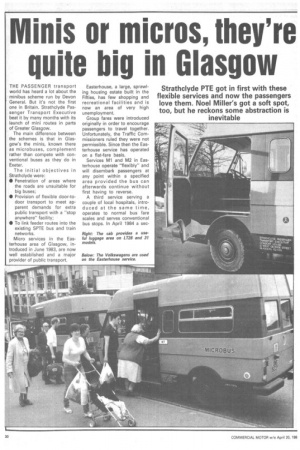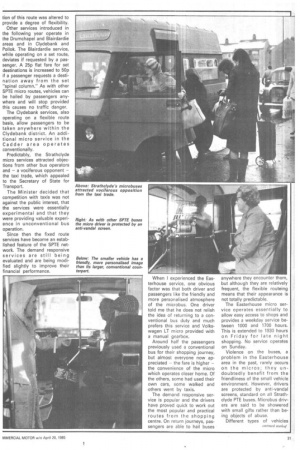Minis or micros, they're quite big in Glasgow
Page 32

Page 33

Page 34

If you've noticed an error in this article please click here to report it so we can fix it.
Strathclyde PTE got in first with these flexible services and now the passengers love them. Noel Miller's got a soft spot, too, but he reckons some abstraction is inevitable
THE PASSENGER transport world has heard a lot about the minibus scheme run by Devon General. But it's not the first one in Britain. Strathclyde Passenger Transport Executive beat it by many months with its launch of mini routes in parts of Greater Glasgow.
The main difference between the schemes is that in Glasgow's the minis, known there as microbuses, complement rather than compete with conventional buses as they do in Exeter.
The initial objectives in Strathclyde were: • Penetration of areas where the roads are unsuitable for big buses; • Provision of flexible door-todoor transport to meet apparent demands for extra public transport with a "stop anywhere" facility; • To link feeder routes into the existing SPTE bus and train networks.
Micro services in the Easterhouse area of Glasgow, introduced in June 1983, are now well established and a major provider of public transport. Easterhouse, a large, sprawling housing estate built in the Fifties, has few shopping and recreational facilities and is now an area of very high unemployment.
Group fares were introduced originally in order to encourage passengers to travel together. Unfortunately, the Traffic Commissioners ruled they were not permissible. Since then the Easterhouse service has operated on a flat-fare basis.
Services M1 and M2 in Easterhouse operate "flexibly" and will disembark passengers at any point within a specified area provided the bus can afterwards continue without first having to reverse.
A third service serving a couple of local hospitals, introduced at the same time, operates to normal bus fare scales and serves conventional bus stops. In April 1984 a sec don of this route was altered to provide a degree of flexibility.
Other services introduced in the following year operate in the Drumchapel and Blairdardie areas and in Clydebank and Poilok. The Blairdardie service, while operating on a set route, deviates if requested by a passenger. A 25p flat fare for set destinations is increased to 50p if a passenger requests a destination away from the set "spinal column." As with other SPTE micro routes, vehicles can be hailed by passengers anywhere and will stop provided this causes no traffic danger.
The Clydebank services, also operating on a flexible route basis, allow passengers to be taken anywhere within the Clydebank district. An additional micro service in the Cadder area operates conventionally.
Predictably, the Strathclyde micro services attracted objections from other bus operators and — a vociferous opponent — the taxi trade, which appealed to the Secretary of State for Transport.
The Minister decided that competition with taxis was not against the public interest, that the services were essentially experimental and that they were providing valuable experience in unconventional bus operation.
Since then the fixed route services have become an established feature of the SPTE network. The demand responsive services are still being evaluated and are being modified slightly to improve their financial performance.
When I experienced the Easterhouse service, one obvious factor was that both driver and passengers like the friendly and more personalised atmosphere of the microbus. One driver told me that he does not relish the idea of returning to a conventional bus duty and much prefers this service and Volkswagen LT micro provided with a manual gearbox.
Around half the passengers previously used a conventional bus for their shopping journey, but almost everyone now appreciated -the fare is higher — the convenience of the micro which operates closer home. Of the others, some had used their own cars, some walked and .others went by taxis.
The demand responsive service is popular and the drivers have proved quick to work out the most popular and practical routes from the shopping centre. On return journeys, passengers are able to hail buses anywhere they encounter them, but although they are relatively frequent, the flexible routeing means that their appearance is not totally predictable.
The Easterhouse micro service operates essentially to allow easy access to shops and provides a weekday service between 1000 and 1700 hours. This is extended to 1930 hours on Friday for late night shopping. No service operates on Sunday.
Violence on the buses, a problem in the Easterhouse area in the past, rarely occurs on the micros; they undoubtedly benefit from the friendliness of the small vehicle environment. However, drivers are protected by anti-vandal screens, standard on all Strathclyde PTE buses. Microbus drivers are said to be showered with small gifts rather than being objects of abuse.
Different types of vehicles used on the micro routes are as much the subject of evaluation as the mode concept itself. At present the fleet includes four 16-seat Dormobile-bodied Bedford CF350s, three Volkswagen LT28D Devon Conversions and seven slightly heavier LT31D 12-seaters, four Renault Masters Converted in the PTE workshops, two heavier Dodge 50 S46 Reeve Burgess-bodied 16-seaters and three Ford Transits.
The Transits are all 16-seaters; one has a Dorrnobile body and the remainder Mellor Coachcraft bodies.
The latest figures show the Renaults are reliable and economical. The 12-seaters have achieved 98.2 per cent availability, 99 per cent reliability, 1.6 per cent service downtime and an average fuel consumption of 22.91mpg.
The Dodge 50 and Ford vehicles have both proved extremely reliable in service; the Dodges achieve 84.1 per cent availability but return only 14.43mpg. The Transits' availability percentage is 73 and their fuel consumption 21.06mpg.
The Volkswagens — the VWs and Bedfords have been in service the longest — have achieved 83.9 per cent availability and and average 20.81mpg. The Bedford figures are 61.8 per cent availability and 22.86mpg.
The Strathclyde evaluation clearly establishes both that people like minibuses and that minis can complement existing bus networks. Their financial performance in the big fleet context is satisfactory and, I am told, is improving as the maihtenance staff become accustomed to dealing with smaller and lighter vehicles.
Presenting better and more attractive travel opportunities will abstract some passengers from existing traditional services, but to an extent this achievement establishes that mini services are in "the public interest".
Most transport pundits agree that deregulation will establish a greater role for small vehicles, which, on short routes, can be successful for operators large or small. The Strathclyde scheme in particular helps the elderly and infirm. While the minis' size makes their cost per passenger-mile potentially less attractive than that of fully laden big buses, it is much better than for taxis.




















































































